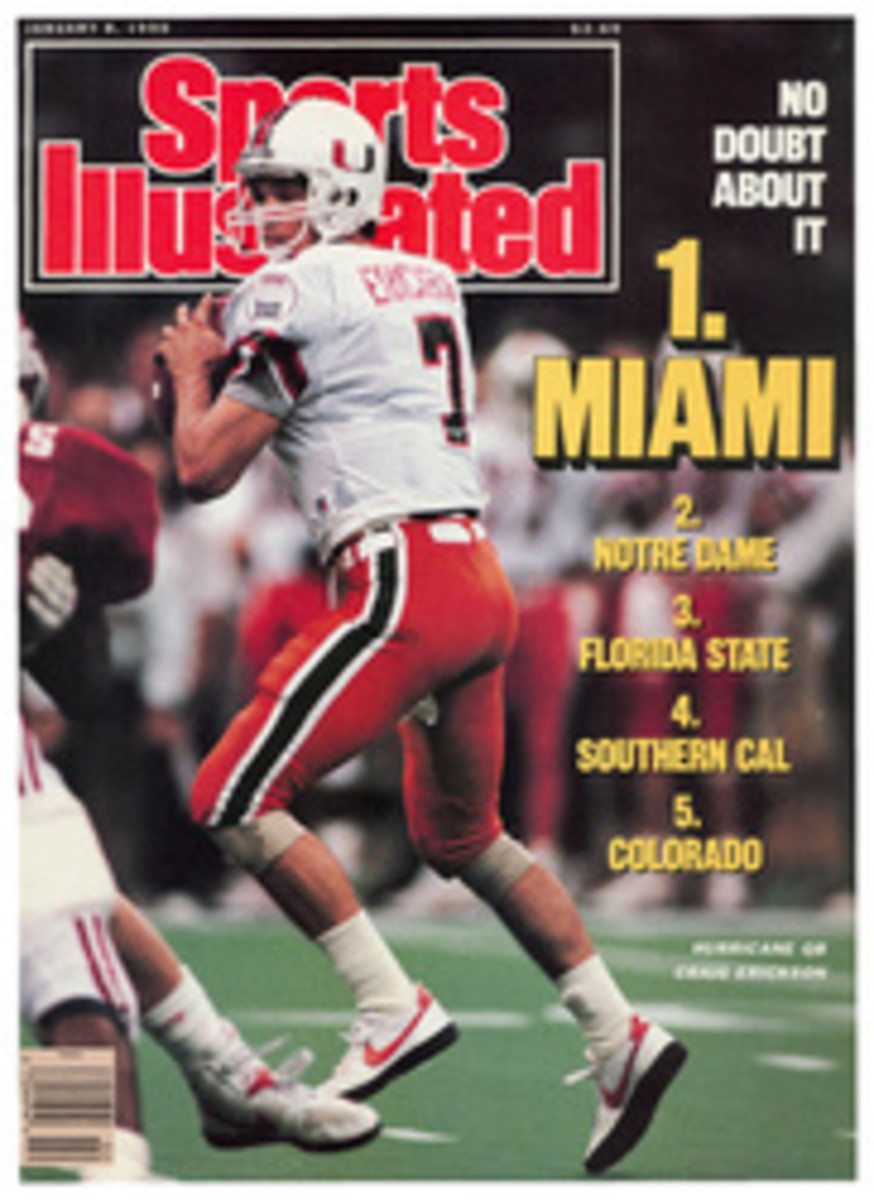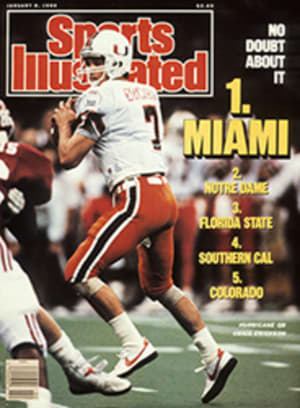
THE SHOT DOCTOR IS HAPPY TO MAKE HOUSE CALLS
Ernie Hobbie is watching me shoot the basketball. I am about six feet from the hoop, looking at the middle eyelet on the front of the rim, knees bent, feet spread shoulder width, perfectly poised to release my shot—except for one thing. "Look," says Hobbie, yanking my off-arm away and watching as the ball rolls off the fingertips of my right hand and onto the hardwood. "You see how you're using your left hand as a support rather than as just a guide? If you get the left hand too involved, you're going to have a shot that's more like a fling than a stroke."
Old habits are hard to break, but I hope it's not too late for me finally to learn how to shoot a basketball the right way. My playing time is down to a weekly 30-and-over game, but I have decided it doesn't matter. I want to shoot a classic jump shot, the kind Larry Bird shoots: left hand lightly cupped on the side of the ball, right hand launching it with a wrist flick so that it gets lots of backspin—what shooters call "good rotation"—on its arcing flight to the heart of the basket. I can remember a player on my high school jayvee team who had reached my aesthetic ideal. Watching him, I was always filled with envy. His shot actually sounded different when it went in—ripping through the net, like Greg Louganis hitting the water on a dive. Looking good—that's what I'm after now.
Hobbie has agreed to help me realize my dream because he loves teaching people how to shoot. In fact, he has been so successful at showing players the way to attain the perfect stroke that he is known in hoopdom as a Shot Doctor. Well, maybe not the Shot Doc, as in the only one, but Hobbie is one of maybe half a dozen Docs with a hoops practice. In civilian life he is an elementary school principal in Plainfield, N.J., but when not deskbound, the 59-year-old Hobbie spends most of his time making house calls on ailing shooters. Among his more famous patients are Kelly Tripucka (Charlotte Hornets), Roy Hinson (New Jersey Nets) and Buck Williams (Portland Trail Blazers). Sometimes he treats players from college teams such as Georgia Tech and Seton Hall.
Hobbie was a good shooter during his high school days, in Cranford, N.J., but admits he was "never a great player." In 1951, after graduating from New Jersey State Teachers College (now Kean College) in Union, N.J., he began what has become a 39-year career as a teacher, coach and administrator in New Jersey schools. From 1953 through '59, he coached freshman basketball at Cranford High—while Rollie Massimino and, later, Hubie Brown coached the jayvees. Shooting was the part of the game that most fascinated Hobbie, and after the '59 season he decided to leave the set plays, half-court offenses and zone traps to others so he could teach shooting exclusively. Hobbie does not charge for his services.
"I'll go anywhere as long as it doesn't cost me money," he says. "Cover my travel expenses, put me up somewhere, give me a couple of bucks to eat with and I'm happy."
Hobbie doesn't spout revolutionary theories about shooting. What he has done is to break the process down so he can instantly spot flaws in a player's technique. "If we're beginning from scratch, the place I start is with the feet," says Hobbie. "You want a good, comfortable base, squared up to the basket, weight equally distributed on the balls of your feet, your knees bent, your butt out and your toes pushing down into the floor to elevate your body. Aside from that, what I stress most is the balance of the ball on the hand. The best way to find the balance point is to turn your hand palm up in front of you and rest the ball on the pads of your fingers—not on the heel of your hand. Oscar Robertson started with the ball on his palm, and he was one of the great shooters of all time, but I wouldn't recommend learning that way.
"So, balance the ball the way I said, on the finger pads, and then turn it over into shooting position, with your elbow as high as your shoulder. Lift the ball above the shooting eye so that your thumb is somewhere between your eyebrow and your hairline. That keeps the ball out of your vision. But don't cock the hand back to the 'busboy' angle. A good rule is to bend the wrist back until the skin wrinkles."
Hobbie, who once canned 310 straight free throws and who made 100 in a row as recently as three years ago, hands the ball to me. "Now we do what I call my Statue of Liberty drill," he says. "You start in close, shooting with just the one hand, focusing on the middle net hook at the front of the basket, pushing down with the toes and lifting the heels. When you shoot you want to imagine that you're curling your fingers over the front of the rim. After you get comfortable and have success shooting that way, I let you use your other hand, but just to guide the ball.
"You work in close with my techniques—very close, like six feet—then gradually fan out and back. I don't let a guy shoot from farther back until he has shown me that he has mastered technique from in close, because the tendency, as you move farther out, is for the technique to break down. That's when you start shooting with two hands or thumbing the ball to get the extra distance."
In working with the pros, Hobbie concentrates on small defects that he can correct within the framework of their basic shot. "I've been shooting the same for years," says Portland's Williams, "but there are minor mistakes I fall into, like not keeping my body square or drifting to one side. Coach Hobbie picks up on those things right away."
Hobbie says that the only way to make major changes in the shooting style of a longtime ballplayer is to work with him in the off-season. "That's because in a game the tendency is to go back to the way you have done things all your life," he says. "But if you take a month off and work on getting a real stroke, and every day you practice, practice, practice, then you have a chance to break bad habits. You get into games, and that stroke stays with you."
Repetition, of course, is more successful in combination with the proper technique. And technique, Hobbie believes, is of the utmost importance in free throw shooting. "Having a sound basic stroke is crucial to developing a positive attitude at the foul line," he says. "When you have a stroke—the kind I teach—there is less that can go wrong. It's grooved, always the same. You should be able to do it blindfolded."
In fact, Hobbie has a drill in which players shoot with their eyes closed. "Then, when you get up to the line, you're going to be very confident," he says. "I'm always saying, 'Stroke, and you'll never choke.' "
None of Hobbie's precepts, however, will pay off unless the players, and their coaches, are fully behind his teaching. "[Coach] Bobby Cremins at Georgia Tech is great that way," says Hobbie. "When I write a prescription for a player, Cremins makes sure the player follows it to a T" Hobbie's work with a few of the New Jersey Nets' players last year did improve the team's performance at the free throw line, if only minimally.
After the Shot Doctor leaves, I practice what he has taught me. I can see that it will work, but I can also see that it's going to take time—a lot of time. I realize that I am not going to be a good patient. I wish I had learned the proper way to shoot 20 years ago. But I didn't. What I did learn, I became pretty good at—as good as I'll ever need to be for a once-a-week game.
So I step to the foul line and revert to my comfortable knuckle-ball fling. I think of that kid from my jayvee team with the perfect stroke. I think of Bird. I think the best thing about guys like that, really, is being able to watch them. If, in spite of my ungainly form, I can knock down nine out of 10 free throws, more power to me. Ugly as my reality is, I am certain the Shot Doctor would agree.
PHOTO
LANE STEWART
Hobbie prescribes holding the ball high and out of the line of vision for foul shots.
PHOTO
LANE STEWART
Hobbie's personal best is 310 successful foul shots in a row.
PHOTO
LANE STEWART
The ball should rest on the pads of the fingers, not the palm.
Free-lance writer Peter Alson claims to have made 28 foul shots in a row.

